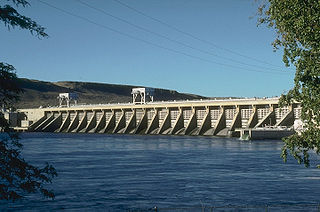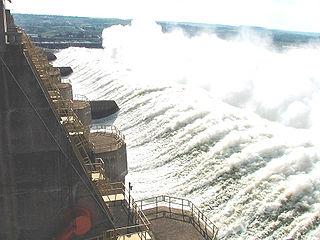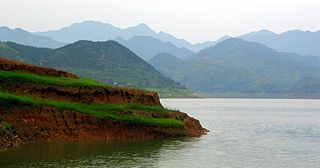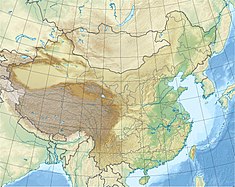
McNary Dam is a 1.4-mile (2.2-km) long concrete gravity run-of-the-river dam which spans the Columbia River. It joins Umatilla County, Oregon with Benton County, Washington, 292 miles (470 km) upriver from the mouth of the Columbia. It is operated by the U.S. Army Corps of Engineers' McNary Lock and Dam office. The dam is located a mile (2 km) east of the town of Umatilla, Oregon, and 8 miles (13 km) north of Hermiston, Oregon. The dam was originally planned to be named Umatilla Dam, but the Flood Control Act of 1945 renamed the dam in honor of Senator Charles L. McNary of Oregon, who had died the previous year.
Longtan Dam is a large roller-compacted concrete (RCC) gravity dam on the Hongshui River in Tian'e County of the Guangxi Zhuang Autonomous Region, China, a tributary of the Xi River and the Pearl River. The dam is 216.2 metres (709.3 ft) high and 849 m (2,785 ft) long; it is the tallest of its type in the world. The dam is intended for hydroelectric power production, flood control and navigation. The dam contains seven surface spillways, two bottom outlets and an underground power station. The Longtan ship lift, part of the dam complex, will be the tallest ship lift system in the world.

The Tucuruí Dam is a concrete gravity dam on the Tocantins River located on the Tucuruí County in the State of Pará, Brazil. The main purpose of the dam is hydroelectric power production and navigation. It is the first large-scale hydroelectric project in the Brazilian Amazon rainforest. The installed capacity of the 25-unit plant is 8,370 megawatts (11,220,000 hp). Phase I construction began in 1980 and ended in 1984 while Phase II began in 1998 and ended in 2010. The dam was featured in the 1985 film The Emerald Forest.
The Mianhuatan Dam is a concrete gravity dam on the Tingjiang River in Yongding County, Fujian Province, China. The dam is 113 metres (371 ft) tall and composed of roller-compacted concrete. The main purpose of the dam is hydroelectric power generation and it supports a power station with 4 x 150 MW generators for a combined capacity of 600 MW. Other purposes of the dam include flood control, navigation and irrigation. Construction began in 1998 and the project was completed in June 2002.

The Longyangxia Dam is a concrete arch-gravity dam at the entrance of the Longyangxia canyon on the Yellow River in Gonghe County, Qinghai Province, China. The dam is 178 metres (584 ft) tall and was built for the purposes of hydroelectric power generation, irrigation, ice control and flood control. The dam supports a 1,280 MW power station with 4 x 320 MW generators that can operate at a maximum capacity of 1400 MW. Controlling ice, the dam controls downstream releases to reservoirs lower in the river, allowing them to generate more power instead of mitigating ice. Water in the dam's 24.7 billion m3 reservoir provides irrigation water for up to 1,000,000 hectares of land.
The Jiangpinghe Dam is a concrete face rock-fill embankment dam on the Loushui River near Jiangpinghe village, Zouma Town, in Hefeng County in Hubei Province, China. The purpose of the dam is hydroelectric power generation, flood control and irrigation. The dam houses a hydroelectric power station with 2 x 250 MW generators for a total installed capacity of 500 MW. Its expected generation of 1005 GWh will be transferred to the Central China Power Grid. Construction on the dam began in 2005 and the first generator went online in July 2012. The dam is 221 metres (725 ft) tall, withholding a 1,366,000,000 cubic metres (1,107,434 acre⋅ft) reservoir of which 787,000,000 cubic metres (638,031 acre⋅ft) is active or "useful" storage.
The Baishan Dam is an arch-gravity dam on the Second Songhua River near the town of Baishanzhen, Huadian, Jilin Province, China. The purpose of the dam is hydroelectric power generation and flood control. The dam supplies water to five turbine-generators in two different powerhouses for an installed capacity of 1,500 megawatts (2,000,000 hp) while it can also control a design 19,100 cubic metres per second (670,000 cu ft/s) flood. Additionally, it has a 300 megawatts (400,000 hp) pumped-storage hydroelectric generation capacity. It is named after Baekdu Mountain, near the city of Baishan.
The Silin Dam is a concrete gravity dam on the Wu River in Sinan County, Guizhou Province, China. The dam has an associated hydroelectric power plant with a 1,080 MW capacity utilizing 4 x 270 MW Francis turbine-generators. The dam is 310 m (1,017 ft) long, 117 m (384 ft) high and composed of roller-compacted concrete. Its reservoir has a 1,205,000,000 m3 (976,909 acre⋅ft) capacity, 184,000,000 m3 (149,171 acre⋅ft) of which is flood storage. The dam also supports ship lift. Construction on the dam began in October 2004, the dam began to impound the river in March 2008 and by May 2009, the power plant's first generator was operational. The remaining generators were operational by December 2009.

The Yantan Dam is a gravity dam on the Hongshui River near Dahua County, Guangxi China. The main purpose of the dam is hydroelectric power production and it has an associated 1,210 MW power station consisting of 4 x 302.5 MW Francis turbine-generators.
The Wuqiangxi Dam is a gravity dam on the Yuan River in Yuanling County, Hunan Province, China. The purpose of the dam is flood control, hydroelectric power generation and navigation. The dam supports a 1,200 MW power station along with a three-stage ship lock. Initial construction on the dam began in September 1986 and construction on the dam's structures began in December 1989. All five generators were operational in December 1996.
The Tingzikou Dam is a gravity dam on the Jialing River downstream of Guangyuan in Cangxi County, Sichuan province, China. The purposes of the dam is flood control, irrigation, hydroelectric power production and navigation. The dam supports a 1,100 MW power station and a 500-ton ship lift. The project was approved in October 2009 and after being shelved for 50 years. Construction began soon thereafter and the river was closed-off in January 2010. The dam began to impound its reservoir in May 2013 and the first generator went online in August. On 20 March 2014 the third generator was commissioned and the fourth and final on 29 April 2014.

The Sanmenxia Dam is a concrete gravity dam on the middle-reaches of the Yellow River near Sanmenxia Gorge on the border between Shanxi province and Henan Province, China. The dam is multi-purpose and was constructed for flood and ice control along with irrigation, hydroelectric power generation and navigation. Construction began in 1957 and was completed in 1960. It is the first major water control project on the Yellow River and was viewed as a major achievement of the new People's Republic of China. Subsequently, its image was printed on the country's bank notes. However, due to sediment accumulation in the reservoir, the dam later had to be re-engineered and renovated. The effects from sediment, which include flooding upstream, have placed the dam at the center of controversy and criticism-related arrests by the Chinese government.

The Baozhusi Dam is a gravity dam on the Bailong River, located 23 km (14 mi) northwest of Guangyuan in Sichuan Province, China. Construction on the dam began in 1984, the generators were operational between 1996 and 1998 while the rest of the facilities were complete 2000. The dam was constructed for hydroelectric power generation, flood control and water supply for irrigation and industrial uses. The 132 m (433 ft) tall concrete gravity dam creates a 2,550,000,000 m3 (2,067,319 acre⋅ft) reservoir with a surface area of 61.2 km2 (24 sq mi). On either side of power station at the dam's base, there are two gate-controlled chute spillways. Beside them are two pairs of intermediate sluice-controlled orifice openings. Below the left intermediate opening are two bottom sluices. The total discharge capacity of the spillways and openings is 16,060 m3/s (567,154 cu ft/s). The dam's power station contains 4 x 175 MW Francis turbine-generators which are afford a maximum hydraulic head of 103 m (338 ft) given the dam's height.
The Guxian Dam is a concrete gravity dam on the Luo River, a tributary of the Yellow River, in Luoning County, Henan Province, China. The primary purpose of the dam is flood control but it also generates hydroelectricity and provides water for irrigation. The 125 m (410 ft) tall dam withholds a reservoir of 1,175,000,000 m3 (952,588 acre⋅ft) and provides 848,000,000 m3 (687,485 acre⋅ft) in flood storage. The dam's power station contains three 20 MW Francis turbine-generators for a total installed capacity of 60 MW. Construction on the dam began in 1958 but was suspended several times afterwards. It recommenced in 1978 and the reservoir began to fill in 1991. The dam's generators were commissioned in 1992 and the project complete in 1993. The dam's spillway is controlled by five tainter gates and has a maximum discharge capacity of 11,436 m3/s (403,859 cu ft/s). Flip buckets are used at the spillway base to dissipate water. On the right side of the spillway there are two intermediate orifice openings controlled by hydraulic press-operated radial gates. Two bottom outlets are set on the spillway's left side, also controlled by hydraulic press-operated radial gates. To the left of the bottom outlets is the power station.
The Huanglongtan Dam is a concrete gravity dam located on the Du River, a tributary of the Han River. It is located 25 km (16 mi) west of Shiyan in Hubei Province, China. The main purpose of the dam is hydroelectric power generation but it also provides for flood control. It was constructed between 1969 and 1976 and support a 510 MW power station.
The Jiangya Dam is a concrete gravity dam on the Loushui River, located 50 km (31 mi) northeast of Zhangjiajie in Hunan Province, China. The primary purpose of the multi-purpose dam is flood control but it also generates hydroelectricty, supplies water for irrigation and municipal use and improves navigation.
The Daguangba Dam is a multi-purpose dam on the Changhua River in Hainan Province, China. It is located 35 km (22 mi) east of Dongfang. As the primary component of the Daguangba Multipurpose Project, the dam was constructed between 1990 and 1995. It serves to provide water for both hydroelectric power generation and agriculture. It supports a 240 MW power station and supplies water for the irrigation of 12,700 ha. It is also the largest dam and hydroelectric power station in Hainan.
Lakhwar-Vyasi Dam project on Yamuna River, includes under-construction Lakhwar Dam and Power Station, Vyasi Dam, Hathiari Power Station and Katapathar Barrage, near the Lakhwar town in Kalsi block of Dehradun district of Uttarakhand in India, for the purpose of irrigation of 40,000 hectare land and total 927 MW hydroelectric power generation. "Lakhwar Dam" is a gravity dam near the Lohari village with 300MW power generation capacity. "Vyasi Dam" will be built 5 km downstream along with 120 MW "Hathiari Power Station" further 0.5 km downstream. "Katapathar Barrage", with the maximum ponding water level at 514.5m elevation, will be built further 2.75 km downstream of the Hathiari Power Station to supply the water to stakeholder states. Project will hold 580 million cubic metres water during monsoon and release into Yamuna during dry months.
The Yinpan Dam is a gravity dam on the Wu River in Wulong County of Chongqing Municipality, China. The primary purpose of the dam is hydroelectric power production and navigation. It supports a 500-ton ship lift and a 600 MW power station. Construction on the project began in 2005 and it was completed in 2011 with the first generator commissioned in May of the same year, the fourth in December.
The ShuiKou shiplift was built in Fujian province, on the Min River. It can lift vessels displacing 500 tons. Its caisson's dimensions are 124 metres (407 ft) × 12 metres (39 ft) × 2.5 metres (8.2 ft). The ShuiKou Dam's maximum height is 101 metres (331 ft).






